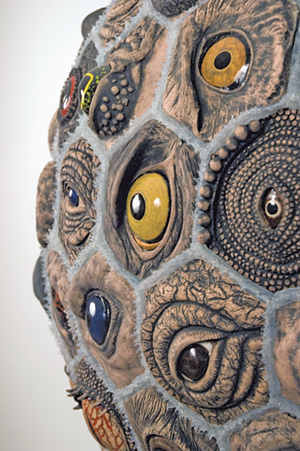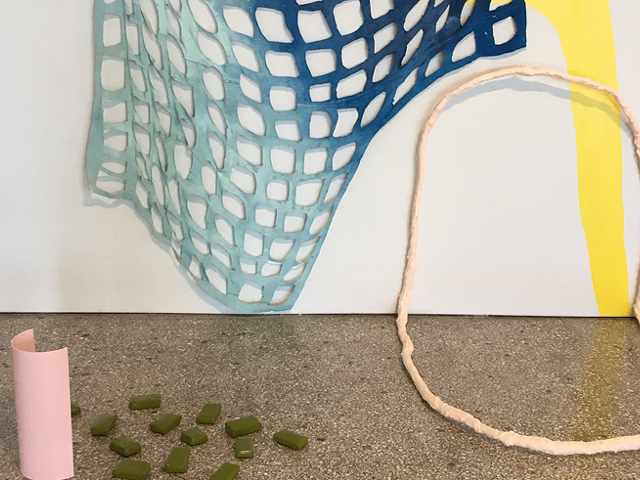Ana England: Kinship, which opened Sept. 8 at the Cincinnati Art Museum, makes the natural world again feel like a friend rather than the adversary it can seem after hurricanes Harvey, Irma and Maria ripped up familiar landscapes.
We tend to take comfort in repetition whenever there is chaos and, over and over, England uncovers recognizable patterns that transcend boundaries. In the carved ceramic panels of “Shared Identity II,” we see that the whorl of a thumbprint looks like the spiral of a galaxy… which looks like the cross-section of a tree… which looks like a hurricane. Mother Nature might not always have a tender touch, yet it’s reassuring to find her fingerprints everywhere. She has a plan for creating new life out of destruction and decay.
England, who lives on a large wooded property in rural Clermont County, led the ceramics program at Northern Kentucky University for 30 years. Inspired by conversations with her physicist father, she considers everything from microscopic organisms in the sea to the expansive cosmos as she looks for links to humans’ existence.
Most visitors to the first-floor exhibit across from the Terrace Café might not know England’s name, but many should be familiar with one of Kinship’s most prominent works. “Night Sky Spiral II,” a dark swirl of 43 ceramic discs, hung in the café from 2003 to 2015, until it was moved to the new third-floor galleries.
Those who had viewed the raku pieces only during a bustling lunch hour can get lost in the stars when entering Kinship. The sense of wonder that envelops the entire exhibit begins with gazing upon the mysterious nebulae suggested by the white specks and wisps on each smoke-colored disc. One universal connection after another then falls into place through England’s masterful use of spirals, spheres, concentric rings and the hexagon — the six-sided building block of life that’s found in chemists’ formulas, as well as honeycombs, snowflakes and bugs’ eyes.
With repetition at the core of the exhibit, England and Amy Miller Dehan, the museum’s curator of decorative arts and design, deserve kudos for ensuring that Kinship puts visitors on a path of discovery rather than monotony. The graphics at the exhibit’s entrance feature the letters of the title drifting into darkness against the whorl of a thumbprint. We become detectives, searching for more prints and clues along a mysterious trail. A nice addition is a guidebook identifying the 31 animals represented in “See,” a half-sphere of hexagons that compares the eyes of insects, reptiles, birds and mammals (including England’s husband, artist Steven Finke). All of the eyes are presented at the same scale to highlight nature’s oneness.
Nothing seems to escape England’s notice — even molecules. In the 2017 work “Breathe,” clusters of ball bearings representing molecules of nitrogen, oxygen, carbon dioxide, argon and water pop from a wall-sized surface that’s been painted to look like a cloud-dappled sky. In the assemblage “Soil Song,” ceramic and wire hexagons signify the elements that break down twigs and pods but also promote new growth.
England beautifully considers this circle of life in “Self-Portrait with Ancestors,” a statue of porcelain bones that are not all human or even mammalian. She’s positioned a bird skull where her heart would be.
“Aggregate” is another statue, though it depicts single-cell organisms banding together for the purpose of nourishment and reproduction before dying off. But when viewed beside the similarly shaped “Ancestors” figure, “Aggregate” appears to be another self-portrait, and, in a sense, it is.
Kinship offers a holistic perspective on the world. (Or is that the whorled?) Beneath “Night Sky Spiral II,” three bowl-like wooden sculptures take on the appearance of radio telescopes waiting to receive signals from beyond. Concentric rings radiate from the center of each dish, where a ceramic sphere resembles the Earth. We can’t be sure if anyone is trying to reach us, but England’s artistic touch suggests that whatever extraterrestrial life we do find will not seem so alien after all.
ANA ENGLAND: KINSHIP is up through March 4, 2018. More info: cincinnatiartmuseum.org.






